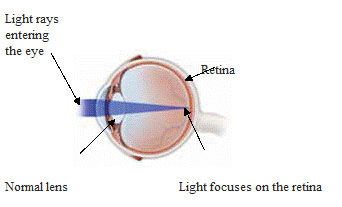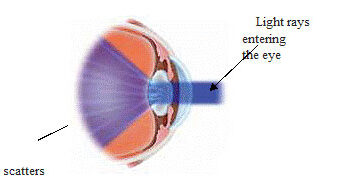What is a cataract?
A cataract is a clouding of the eye’s naturally clear lens. The lens focuses light rays on theretina (the layer of light-sensing cells lining the back of the eye) to produce a sharp image of what we see. When the lens becomes cloudy, light rays cannot pass through it easily and vision is blurred.

Light rays entering an eye with a normal lens

Light rays entering an eye with a cataract. When a cataract forms, the lens of your eye is cloudy.
Light cannot pass through it easily and your vision is blurred.
What causes cataracts?
Cataract development is a normal process of aging, but cataracts also develop from eye injuries, certain diseases, medications or long-term exposure to sunlight. Your genes may also play a role in cataract development.
How can a cataract be treated?
A cataract may not need to be treated if your vision is only slightly blurry. Simply changing your eyeglass prescription may help to improve your vision for a while. There are no medications, eyedrops, exercises or glasses that will cause cataracts to disappear or to prevent them from forming. Surgery is the only way to remove a cataract. When you are no longer able to see well enough to do the things you like to do, cataract surgery should be considered. In cataract surgery, the cloudy lens is removed from the eye through a surgical incision. In most cases, the natural lens is replaced with a permanent intraocular lens (IOL) implant.
What can I expect if I decide to have cataract surgery?
Before surgery: To determine if your cataract should be removed, your ophthalmologist (Eye M.D.) will perform a thorough eye examination. Before surgery, your eye will be measured to determine the proper power of the intraocular lens that will be placed in your eye. Ask your ophthalmologist if you should continue taking your usual medications before surgery. You should make arrangements to have someone drive you
The day of surgery: Surgery is usually done on an outpatient basis, either in a hospital or an ambulatory surgery center. You may be asked to skip breakfast, depending on the time of your surgery. When you arrive for surgery, you will be given eyedrops and perhaps a mild sedative to help make you comfortable. A local anesthetic will numb your eye. The skin around your eye will be thoroughly cleansed, and sterile coverings will be placed around your head. You may see light and movement, but you will not be able to see the surgery while it is happening. Under an operating microscope, a small incision is made in the eye. In most cataract surgeries, tiny surgical instruments are used to break apart and remove the cloudy lens from the eye. The back membrane of the lens (called theposterior capsule) is usually left in place.
During cataract surgery, tiny instruments are used to break apart and remove the cloudy lens from the eye.
A plastic, acrylic or silicone intraocular lens is implanted in the eye to replace the natural lens that was removed. After surgery is completed, your doctor may place a shield over your eye. After a short stay in the outpatient recovery area, you will be ready to go home
In cataract surgery, the intraocular lens replaces the eye’s natural lens.
Followi ng surgery You will need to:
- Use the eyedrops as prescribed;
- Be careful not to rub or press on your eye;
